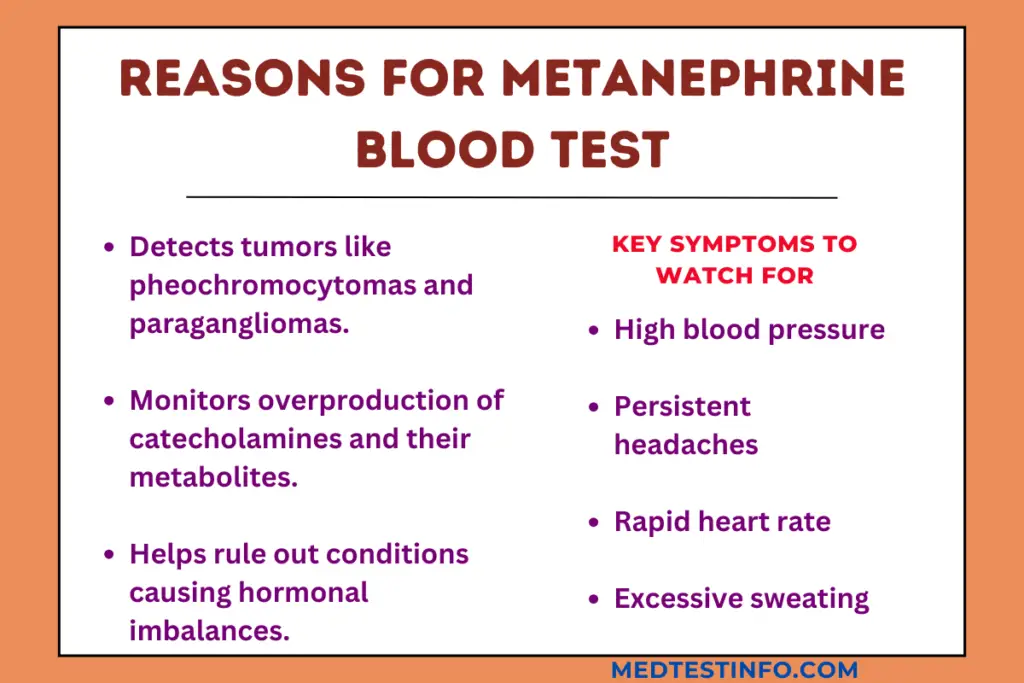
Overview
A blood test for metanephrines is essential for checking the levels of these hormones in the blood. Metanephrines are byproducts of catecholamines, including adrenaline and noradrenaline, hormones generated by the adrenal glands. These hormones are crucial in managing the body’s reaction to stress and regulating blood pressure.
When physicians suspect conditions such as pheochromocytoma or paragangliomas—tumors impacting the adrenal glands—a metanephrine blood test is frequently advised. Higher levels of metanephrines, such as plasma-free and serum metanephrines, may suggest the existence of these conditions, which often result in high blood pressure, headaches, and various other symptoms.
This test is essential for identifying any issues with hormone production, helping to ensure an accurate diagnosis and the proper treatment. But to understand the results of a blood test for metanephrines, you need to know the average range for metanephrines and normetanephrine levels. High levels suggest serious health concerns, while low levels could indicate other problems.
In this article, we’ll explore what a metanephrines blood test is all about, why it’s essential, and how the results can help you make informed choices about your health care. This guide will tell you everything you need to know about the process, goal, and importance of testing for metanephrines, whether you’re looking into this test for yourself or to learn more about the health of a loved one.
What Are Metanephrines?
Metanephrines are byproducts created when the body processes catecholamines, hormones such as adrenaline and noradrenaline. The adrenal glands on top of the kidneys produce these hormones, essential for managing the body’s response to stress and keeping heart rate and blood pressure in check.
How Metanephrines Are Measured
When catecholamines are released, they quickly break down into metanephrine and normetanephrine. A blood test for metanephrines can measure these two main byproducts. These metabolites provide an overview of your body’s hormonal activity, particularly to the adrenal glands.
Why Elevated Metanephrines Matter
Certain medical diseases, such as pheochromocytoma—a tumor of the adrenal glands—cause an unusual increase in hormone production, resulting in increased levels of metanephrines in the bloodstream. Elevated plasma-free or serum metanephrine levels may suggest the existence of these tumors even before symptoms appear.
Normal levels of metanephrines help our bodies handle daily activities and stress. Elevated levels could indicate an issue with the adrenal glands or another part of the endocrine system. In these situations, a metanephrine lab test is a crucial diagnostic tool for doctors.
Understanding the role of metanephrines in our bodies helps us recognize why monitoring these levels with tests such as the plasma metanephrines test is crucial.

Why Is the Blood Test For Metanephrines Ordered?
Identifying Tumors And Hormonal Imbalances
A blood test for metanephrines is mainly requested to identify or rule out particular medical conditions associated with irregular hormone production. This test assists in identifying tumors like pheochromocytoma and paragangliomas, which lead to an overproduction of catecholamines and their metabolites, such as plasma-free metanephrines and normetanephrine.
Doctors frequently advise this test when symptoms indicate a potential hormonal imbalance linked to these uncommon tumours. Typical signs include high blood pressure, persistent headaches, increased heart rate, and excessive sweating. Early diagnosis of pheochromocytomas is necessary because the tumors can cause significant rises in blood pressure and possibly cause serious complications such as heart attacks or strokes.
Observing Symptoms And Care
Doctors might order this test if you experience symptoms such as palpitations, anxiety, or unexplained weight loss. Furthermore, it is beneficial for those with a family history of adrenal gland tumours or genetic conditions that elevate the risk of developing catecholamine-secreting tumours.
For people with secondary hypertension, a metanephrine blood test can help identify whether an underlying adrenal issue is contributing to the condition. It also helps verify abnormal results from other tests, such as urine tests for metanephrines and informs treatment choices.
How This Test Is Done
Getting a blood test for metanephrines is simple, but taking the proper steps beforehand and using the correct technique is essential for reliable results. This test usually checks the plasma-free metanephrines and normetanephrine levels in your blood, assisting doctors in diagnosing adrenal-related conditions such as pheochromocytoma.
Preparation For The Test
Before the test, you might be advised to avoid certain foods, medications, and activities that could affect your hormone levels. Some typical limitations involve avoiding caffeine, alcohol, and strenuous activities. Your doctor might suggest taking a break from medications such as antidepressants or blood pressure medications, as they could affect the results.
The Blood Collection Process
A small blood sample is taken to perform the test, typically from a vein in your arm. A healthcare professional will have you comfortably seated or lying down. They will gently clean the area, insert a needle, and collect your blood into a sterile tube. The process is quick and only takes a few minutes.
For the best results, it is essential to take a break for around 30 minutes before your sample is collected at certain labs. This helps balance your stress hormone levels, ensuring that higher metanephrines aren’t caused by outside influences such as anxiety or physical activity.
After you draw the blood, you can return to your usual routine. After receiving the sample, experts carefully analyze the levels of fractionated catecholamines and their metabolites in the lab. The results are usually ready in just a few days.
Accurate test results are crucial, as even small rises in plasma metanephrines can suggest the possibility of tumours or other health issues. If the results aren’t precise, your doctor might suggest extra tests, like a urine test for metanephrines, to help clarify the situation.

What Does The Test Result Mean?
Understanding the results of a metanephrine blood test is essential for identifying possible health issues. The results usually show whether your plasma metanephrine and normetanephrine levels are normal or elevated, giving you a clearer picture of how your adrenal glands are functioning and your overall health.
Normal Test Results
A result within the normal range of metanephrines indicates that your body is maintaining a healthy balance and not producing too many hormones. The typical values can differ slightly from one lab to another, but they usually align with the well-known ranges for plasma-free metanephrines and normetanephrine. If your results come back standard, it’s probably not the case that you have pheochromocytoma or any similar conditions.
Elevated Metanephrines
Higher levels of metanephrines might suggest an adrenal tumor, like pheochromocytoma or paraganglioma. These tumors lead to an overproduction of hormones, resulting in elevated levels of fractionated catecholamines and their breakdown products. People often experience symptoms such as high blood pressure, rapid heartbeat, and severe headaches alongside these findings.
Sometimes, slightly higher normetanephrine levels don’t necessarily mean a tumor. They could be due to stress, specific medications, or other temporary situations. Your doctor will consider these factors before arriving at a diagnosis.
Low Metanephrines
While it’s uncommon, low levels of metanephrines in the blood or urine can occur due to issues related to adrenal function. We need to investigate this further to understand what’s going on.
If your test results return abnormal, your healthcare provider might suggest follow-up tests, like a urine test for metanephrines or imaging studies, to help confirm the diagnosis. Treatment plans are tailored to each individual’s unique condition and severity.
Related Tests For Accurate Diagnosis
A metanephrine blood test is a reliable way to identify hormonal imbalances, though further tests might be necessary to confirm the diagnosis. These additional tests offer a better understanding, mainly when the results are unclear or unstable.
Urine Test For Metanephrines
A 24-hour urine test for metanephrines is commonly suggested in addition to the blood test. This test looks at the total amount of metanephrines released throughout the day, providing critical information about how hormone levels change over time. This test can benefit individuals experiencing occasional symptoms, like fluctuating high blood pressure or heart palpitations.
Fractionated Catecholamines Test
This test checks the amounts of catecholamines in the blood, such as adrenaline and dopamine. Analyzing metanephrines and metabolites of these hormones can help identify the source of abnormal levels.
Imaging Studies
When blood and urine tests show signs of a tumour, doctors might use imaging techniques such as CT scans or MRIs to locate and evaluate it. These scans help identify pheochromocytomas and paragangliomas, which are essential for planning treatment.
Genetic Testing
Doctors sometimes suggest genetic testing, mainly if there’s a family history of pheochromocytoma or similar conditions. Some gene mutations can raise the likelihood of adrenal tumors, highlighting the significance of this test in a thorough diagnostic process.
Blood Tests For Adrenal Function
Additional blood tests, such as those that check cortisol and aldosterone levels, might be requested to assess the adrenal glands’ functioning. These tests help eliminate other possible causes of hormonal imbalances.
Together, these tests form a thorough diagnostic framework that helps accurately identify issues and plan effective treatments.
Normal Range
The normal range for metanephrines indicates the typical plasma metanephrines and normetanephrine levels in a healthy person. The values differ slightly depending on the laboratory and the testing method used. However, commonly accepted reference ranges are used to understand clinical results.
Plasma Free Metanephrines
Metanephrine: Below 0.50 nmol/L
Normetanephrine: Below 0.90 nmol/L
Factors Influencing Normal Ranges
Your results can be influenced by various factors, such as stress, medications, and certain health conditions. For instance, slightly higher normetanephrine levels don’t always mean a serious problem; it could be related to lifestyle choices or temporary conditions.
Importance Of Interpreting Results In Context
Your healthcare provider will take a look at your metanephrines blood test results, considering your overall health, symptoms, and other tests that have been done. If your levels are normal but you are still experiencing symptoms, it is worth looking into more closely.
Grasping these ranges is essential for evaluating adrenal function and spotting potential problems early on. If your results fall outside the normal range, you might need to undergo follow-up tests, like a urine test for metanephrines or some imaging studies.
Conclusion
A blood test for metanephrines is vital in diagnosing issues connected to adrenal gland function, especially in pheochromocytomas and paragangliomas. This test offers essential insights into hormonal imbalances by measuring plasma metanephrines and normetanephrine levels, which can significantly affect overall health.
An accurate diagnosis usually involves a mix of tests, such as urine tests for metanephrines and imaging studies, to verify results and help determine the best treatment approach. Getting a clear picture of your results, whether in the normal range or a bit higher, allows you and your healthcare provider to work together on the best next steps for your health.
If you have ongoing high blood pressure or persistent headaches, it’s a good idea to see your doctor about whether this test might be suitable for you. Finding issues early and getting the correct diagnosis can make a difference in treatment and overall health.


